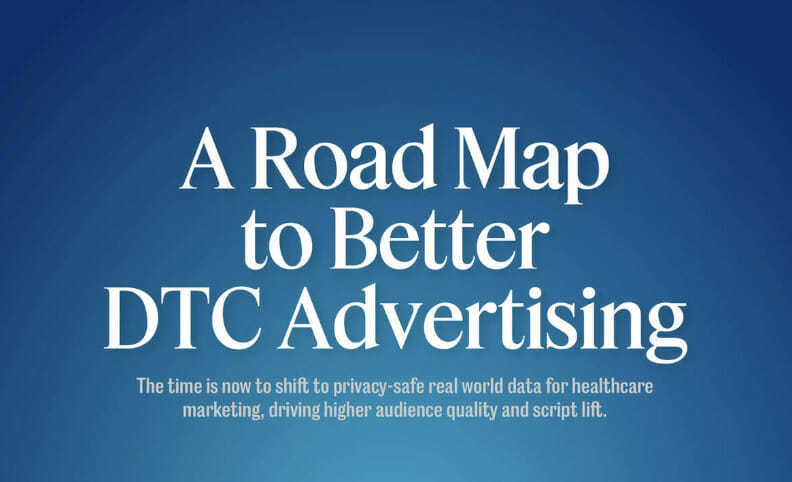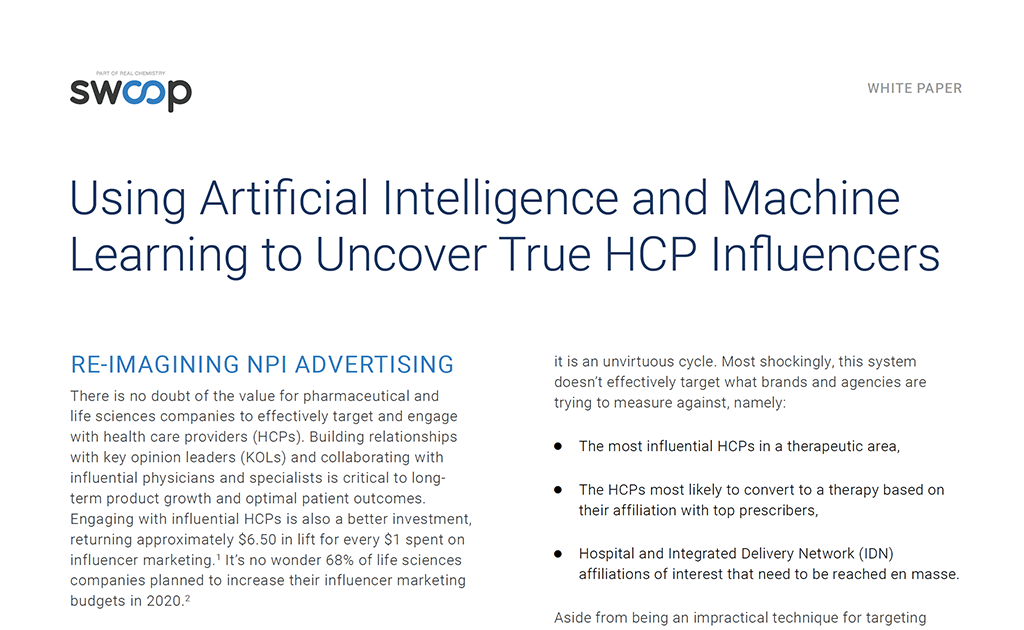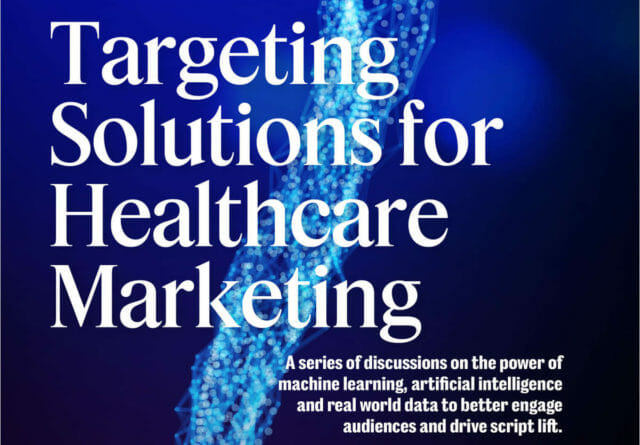Pharma marketers are adapting to a variety of changes that have impacted targeting, privacy and media buys. Data-driven methods allow companies not only to have more informed conversations with patients but also take a more privacy-safe approach to engage the right consumers where they are.
During an MM+M podcast, sponsored by Swoop, editor-at-large Marc Iskowitz sat down with Katie Carr, SVP of sales at Swoop, to discuss how custom audience segments can fit into and activate across the media plan.
Pharma marketers are adapting to a variety of changes that have impacted targeting, privacy and media buys. Data-driven methods allow companies not only to have more informed conversations with patients but also take a more privacy-safe approach to engage the right consumers where they are.
During an MM+M podcast, sponsored by Swoop, editor-at-large Marc Iskowitz sat down with Katie Carr, SVP of sales at Swoop, to discuss how custom audience segments can fit into and activate across the media plan.
Carr kicked off the discussion by explaining that Swoop offers a number of different solutions for advertisers today.
“Swoop offers real world data in conjunction with artificial intelligence and machine learning to create high-quality audience segments that drive script lift,” she said. “We really understand that every brand has its own unique challenges and therapeutic advantages, which is why it’s important to build these segments customized based on those specific needs.” Swoop not only “outperforms the second-best performing initiative by two to four times” but is also “trusted by the top 42 out of 50 pharmaceutical manufacturers and top 18 out of 20 pharmaceutical agencies,” she added.
Creating data-driven solutions
Traditional solutions for pharma marketers include “demographic targeting, zip-nine targeting or location-based targeting, behavioral targeting such as ClickStream and off-the-shelf targeting, which is based on generic real world data,” Carr explained. However, “in most cases, they don’t understand the health status of a patient and in the off-the-shelf option, do not hone in on the specific need of the brand.”
A better solution “for marketers that want to drive a higher script lift and reach patients that qualify for their treatment or for the education they’re looking to put out into the market, is real world data,” said Carr.
Swoop does not “grade our own homework,” she added. When putting real world data to use, “we recommend that a partner work with a third-party vendor to measure the success of all of their programs,” particularly against audience quality. Why? Because “audience quality is a proxy for script lift,” she said.
In addition, with “the big privacy changes happening out of Google, Facebook and Apple, patients today might be engaging with media differently than they did pre pandemic,” Carr added. It’s important “to allow the data to identify where the patients are engaging in order to maximize your marketing dollar today.”
In terms of optimization, Swoop recommends that clients “share their performance metrics on a weekly basis,” she said. That way it’s possible to “identify if a segment isn’t performing as well as it should be,” if “a segment needs to be rebuilt” or if “we are using the correct ICD-10 codes.”
Reimagining provider and patient engagement
According to MM+M’s 2022 Healthcare Marketers Trend Report in partnership with Swoop, MM+M found that only 35% of marketers were using custom audiences and that marketing budgets were up 15% but not yet at pre-pandemic levels.
“The reality is real world data hasn’t been around that long,” Carr explained. Today, the issue is not “do vendors have access to data?” but instead “what are they doing with the data?”
While many advertisers were “ready to start reinvesting, they are now saying to, hold on, given all the changes in the marketplace,” she said. The truth is “the opportunities for where we can advertise are becoming a lot more fragmented and limited.” That’s why it’s important “to educate yourself on what the options are, reach out to Swoop or other vendors you work with and ask those people for their advice,” Carr advised. After all, “we’re all in this together.”
The MM+M survey also found that marketers are increasing their patient marketing budgets. As media consumption habits change, “understanding where those patients are today is probably one of the hardest things for advertisers,” said Carr. “And that’s where I recommend leaning on the data that can inform where those patients are engaging.”
Activating across multiple channels
“Wherever you’re buying your media today, you can layer on data to make it more efficient,” said Carr. Data can be leveraged across “programmatic, which includes CTV and audio, addressable TV and linear TV.”
Swoop, for example, can also be used “for planning purposes,” Carr said. “For linear planning, we’re sending our segments to Nielsen or a proprietary agency planning too.” Swoop recently became the first healthcare data provider to integrate its audiences with Nielsen for planning purposes.
Today, “data can be used across any media platform and can also inform the media mix itself,” she explained.
At Swoop, “all of our segments are customized specifically for the brand, the drug and the campaign’s imperative,” Carr said. She cited a client looking to reach recently diagnosed and commercially insured heart failure patients or melanoma patients diagnosed in the last six months as examples. “There are a lot of different and unique things that we can do, it’s just going to be based on what the client’s specific need is and what they’re trying to accomplish,” she added.
In the end, “the No. 1 KPI is always going to be script lift,” Carr said. “Once you validate the data, it makes sense to consistently use the same data asset for your planning, your activation and your measurement. In fact, that’s the ‘dream state,’ when you can use high-performing, high-quality data for your entire process.” Abbot, for example, recently “leveraged Swoop data and saw a 14-time increase in their ROI.”
At Swoop, “we put privacy first,” Carr concluded. In addition, “there essentially is no cost for entry” as the company does not “charge for customization of a segment.” Lastly, “if you need advice, we’ve got experts in pharmaceutical data and privacy at our fingertips.”









